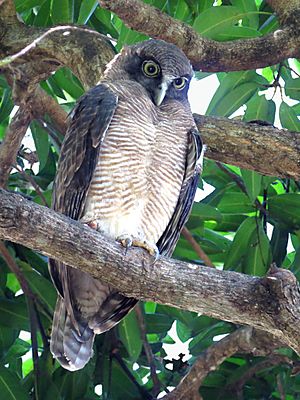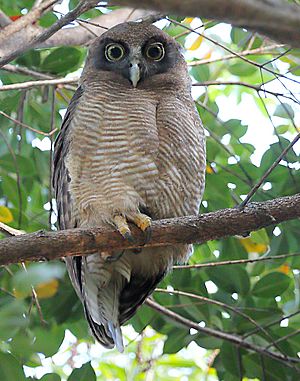Rufous owl facts for kids
Quick facts for kids Rufous owl |
|
|---|---|
 |
|
| Conservation status | |
| Scientific classification | |
| Genus: |
Ninox
|
| Species: |
rufa
|
The rufous owl (Ninox rufa) is a type of owl found in places like Australia, Indonesia, and Papua New Guinea. It's also called the rufous boobook. This owl got its name because its feathers are a reddish-brown color, which is called "rufous." Even though it's not seen very often, it lives in a wide area.
This owl is quite large. It can weigh from about 700 grams to 1700 grams. This depends on if it's a male or female, and how old it is. The rufous owl is a bit smaller than Australia's biggest owl, the powerful owl. Rufous owls hunt at night and usually live alone. They are not usually aggressive towards people. However, they will protect their nest or babies if they feel threatened.
Contents
About the Rufous Owl
The rufous owl is a big bird. It can grow to be about 46 to 57 centimeters long. Its wingspan can be between 100 and 120 centimeters. Female owls usually weigh between 700 and 1050 grams. Male owls are a bit heavier, weighing from 1050 to 1300 grams.
Both male and female rufous owls have small heads compared to their bodies. The male's head is flatter and wider. When they are born, baby owls are tiny, only about 49 to 54 millimeters long. They are covered in soft, white fluff.
Adult owls have dark reddish-brown feathers on their forehead, neck, back, and upper wings. These feathers have light brown stripes. Their face is dark brown. Their neck, chest, and belly are rufous (reddish-brown) with thin cream-colored stripes. The underside of their wings is light brown with thick cream stripes. They have a light grey, hooked bill with black bristles around its base. Their eyes are a bright golden-yellow.
Different Kinds of Rufous Owls
There are five slightly different types, or subspecies, of the rufous owl. They vary a little in size and color. These are:
- Ninox rufa rufa (Gould, 1846)
- Ninox rufa aruensis (Schlegal, 1866)
- Ninox rufa humeralis (Bonaparte, 1850)
- Ninox rufa meesi (I.J. Mason & Schodde, 1980)
- Ninox rufa queenslandica (Matthews, 1911)
Where They Live
The rufous owl lives in many different places. It is found in the Aru Islands, New Guinea, and northern Australia. In Australia, you can find it in Arnhem Land, the northern Kimberleys, the eastern Cape York Peninsula, and the Mackay District of eastern Queensland. It is the only owl in Australia that lives only in tropical areas.
We don't know exactly how many rufous owls there are in the world. However, they are thought to be uncommon or rare. These owls live in land environments. They mostly live in rainforests and around the edges of rainforests. They can also be found in other forests, moist savannas, and wetlands inland.
Owl Behavior
Rufous owls are usually shy and hard to spot. But they can become aggressive if they feel threatened. They are almost always active at night. During the day, they stay in their nest or a safe spot to rest. They don't make much noise, except during the time they are raising their young.
During the breeding season, male and female owls talk to each other using different calls. The female's voice is higher pitched than the male's.
Reproduction and Life Cycle
Rufous owls usually have their breeding season from June to September. The exact time depends on how warm their home is. To start breeding, the male owl makes a special double call to attract a female. As she flies towards him, the female makes excited trills in return.
They usually lay their eggs in a nest built inside tree trunks or large branches. Some nests are built as high as thirty meters off the ground. This helps keep them safe from predators that live on the ground. The male owl chooses the nest. The female then lays one or two eggs inside. The eggs need to be kept warm for 37 days. This process is called incubation.
Once the young owls hatch, they depend on their parents for many months. They often stay with their parents until the next breeding season. Both the male and female owls will fiercely protect their nest from predators and anyone who comes too close while their young are still inside.
What They Eat
The rufous owl is a very good and strong hunter. It can catch many different kinds of prey. Their diet is very varied. They eat birds, insects, and small mammals like flying foxes. They have been seen eating mammals as small as 5 to 15 grams. They also eat larger tree-dwelling marsupials, like the Northern brushtail possum, which can weigh up to 2000 grams. Usually, the rufous owl hunts the younger ones of these larger animals.
Some mammals they have been seen eating include:
- Little red flying fox (Pteropus scapulatus)
- Black flying fox (Pteropus alecto)
- Brush-tailed phascogale (Phascogale tapoatafa)
- Northern brushtail possum (Trichosurus arnhemensis)
- Sugar glider (Petaurus breviceps)
- Black-footed tree-rat (Mesembriomys gouldii)
- Brush-tailed rabbit rat (Conilurus penicillatus)
- Northern brown bandicoot (Isoodon macrourus)
- Pale field rat (Rattus tunneyi)
- Dusky field rat (Rattus colletti)
They also catch birds like the orange-footed scrubfowl (Megapodius reinwardt) and the eclectus parrot (Eclectus roratus).
What they eat can change with the seasons. For example, during the wet season, when plants on the ground are thicker, these owls might hunt more birds instead of mammals that live on the ground. What they hunt also depends on what animals are available at different times of the year.
Rufous owls use several ways to catch their food. They might grab prey from a tree branch, snatch it from tree leaves while flying, chase it in the air, or swoop down from the sky to catch prey from the ground or water.
Conservation Status
The IUCN Red List of Threatened Species keeps track of how endangered animals are. The rufous owl (Ninox rufa) is not considered an endangered species. In 2016, it was listed as a species of Least Concern. This means it's not currently at high risk of disappearing.
Even though its population seems to be getting smaller, it's not decreasing fast enough to be called "vulnerable." Its numbers have gone down by less than 30% over the last ten years or three generations. However, like many other birds, the rufous owl faces threats. These include hunting, forests being cut down, and forest fires during the dry seasons.
See also
 In Spanish: Nínox rojizo para niños
In Spanish: Nínox rojizo para niños



